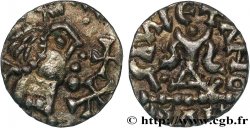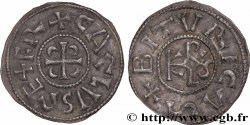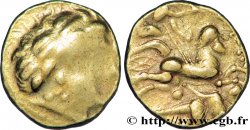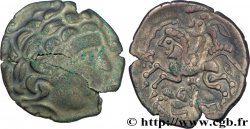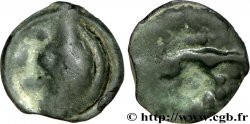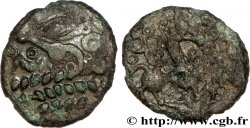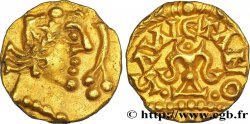bmv_277700 - MEROVINGIAN COINAGE - BANASSAC (BANNACIACO) - Lozere Triens au vase et au rameau à trois branches
Not available.
Item sold on our e-shop (2016)
Price : 2 800.00 €
Item sold on our e-shop (2016)
Price : 2 800.00 €
Type : Triens au vase et au rameau à trois branches
Date: c. 620-640
Date: s.m.
Mint name / Town : Banassac (48)
Metal : gold
Diameter : 11,5 mm
Orientation dies : 3 h.
Weight : 1,22 g.
Rarity : R2
Coments on the condition:
Monnaie complète, sur un flan un tout petit peu court. Frappe vigoureuse et centrée des deux côtés. Flan en assez bon or avec une surface homogène
Catalogue references :
Obverse
Obverse legend : ANÉPIGRAPHE.
Obverse description : Tête barbare diadémée, à droite ; diadème très saillant à la tranche perlée ; calotte et bouton occipital ; devant le profil, rameau renversé à trois baies.
Reverse
Reverse legend : GAVALETANO / BAH.
Reverse description : Calice à deux anses, entre deux globules, posé sur une ligne d’exergue perlée ; légende autour et à l’exergue.
Commentary
Ce type précis, avec le rameau à trois baies, correspond à la variété E du Belfort regroupant les monnaies B. 754-747. Toutes les monnaies de ce type ont un vase entre deux globules
Ce triens correspond au groupe 12-2E pour lequel seulement 6 exemplaires ont été étudiés (les quatre du Belfort, le n° 25 d’Avignon et un exemplaire passé en vente au Crédit e la Bourse en 1994).
Le n° 423 de Cambridge a ce même avers, mais associé à la légende TELAFIVS MONETA..
This specific type, with the three-berry branch, corresponds to variety E of Belfort, which includes coins B. 754-747. All coins of this type have a vase between two globules. This triens corresponds to group 12-2E, for which only 6 examples have been studied (the four from Belfort, No. 25 from Avignon, and a example sold at Crédit e la Bourse in 1994). No. 423 from Cambridge has this same obverse, but associated with the legend TELAFIVS MONETA.
Ce triens correspond au groupe 12-2E pour lequel seulement 6 exemplaires ont été étudiés (les quatre du Belfort, le n° 25 d’Avignon et un exemplaire passé en vente au Crédit e la Bourse en 1994).
Le n° 423 de Cambridge a ce même avers, mais associé à la légende TELAFIVS MONETA..
This specific type, with the three-berry branch, corresponds to variety E of Belfort, which includes coins B. 754-747. All coins of this type have a vase between two globules. This triens corresponds to group 12-2E, for which only 6 examples have been studied (the four from Belfort, No. 25 from Avignon, and a example sold at Crédit e la Bourse in 1994). No. 423 from Cambridge has this same obverse, but associated with the legend TELAFIVS MONETA.








 Report a mistake
Report a mistake Print the page
Print the page Share my selection
Share my selection Ask a question
Ask a question Consign / sell
Consign / sell
 Full data
Full data
